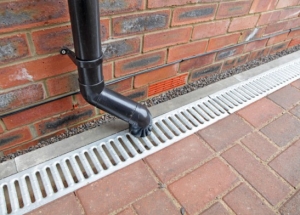If a person decides to purchase a plot of land for his or her blood, he will choose the site for a long time and pick up what he needs, select a land that is able to please not only a beautiful lawn, but also bring edible gifts of nature. Fortunately, the state cares about its not very well-off citizens and allocates land for free - and when this landowner begins to develop the plot, it often turns out that the trees do not grow, the garden does not yield, and the foundation of the house that the owner built starts to shrink, and in the basement every spring receives a large amount of water, etc. And the reason for this - an increased level of humidity in this area or high, close-passing groundwater. And here you really do not want to, but you have to equip the drainage area. Do not be afraid of this work, since this procedure is not particularly complicated, especially since plastic pipes http://truba-ptm.ru/ are available to almost everyone due to their low price and having rolled up their sleeves, having worked for a couple of weeks, you can do the drainage of the site with your own hands. Yes, you will have to work hard, but this work will help to preserve your structure, and the land will yield an excellent harvest.
Content
Drainage system, drainage system design
Drainage is open or closed type, the choice of type of drainage depends on the cause of flooding your site.
The moisture can be retained on the site only because of the clay soil structure.
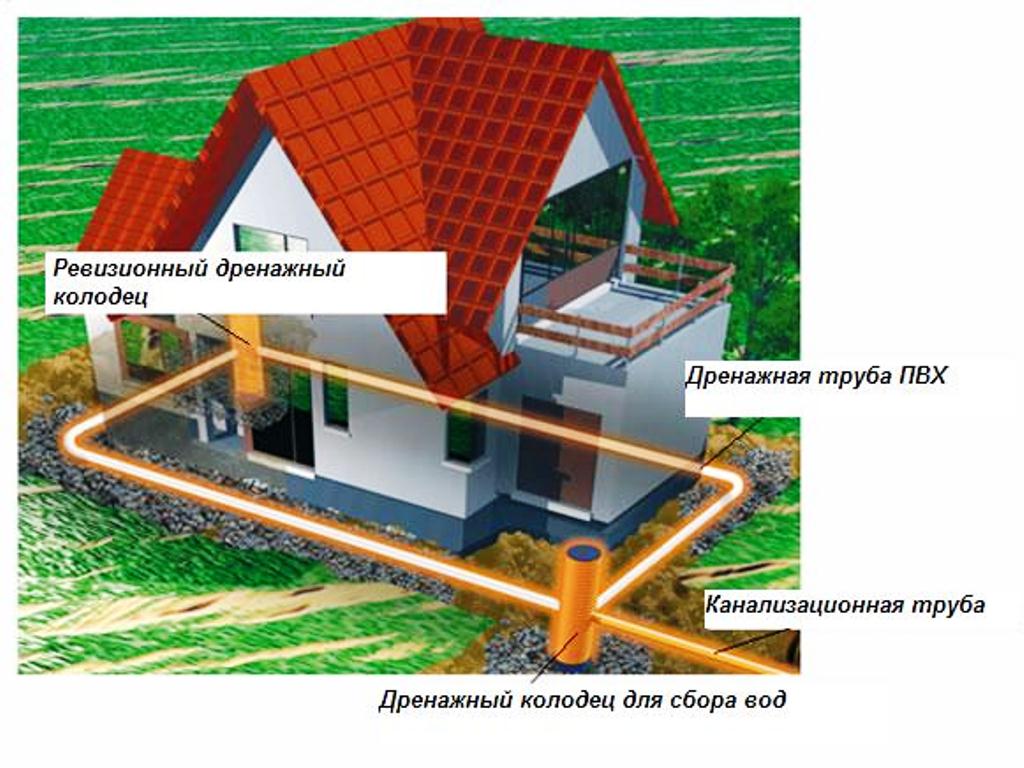
Clay is able to hold up on its surface all the moisture from the rain and snow. If there is such soil on your land, it is enough just to create an open drainage system of excessive moisture and excess moisture will leave the surface of your land.
But if on your site the ground waters are located close to the surface - you will have to lay a more complex closed deep drainage.
A high rise in groundwater is mainly in the spring period, because of this, the basement is submerged, ground is being heaped, the foundation is eroding, the plantings are getting wet and dying, and so on. To get rid of excess moisture, it is necessary to install a closed drainage system.
Below, we will consider the simplest ways of laying drainage on flooded areas.
Drainage system, open surface drainage locally
An open drainage system can be created even without drawing up a scheme, but you can go through the site and draw up a scheme with certain local areas of flooding.
The simplest option in creating an open drainage system is the creation of drainage of the local (in some places).
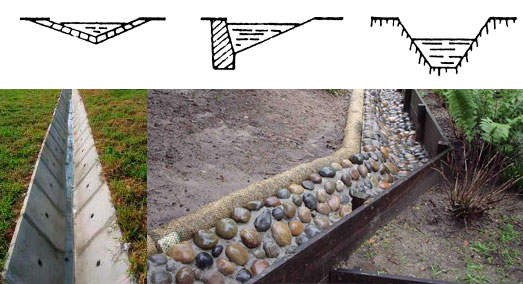
This type of drainage is relevant for those areas where there are several points of collection of excess moisture during a large precipitation. The landlord knows these places, in the place where the water stagnates, water inlets or containers with a lid are dug into the ground, and slots are made for the collection of water in the lid.
This water can, afterwards, be used for watering the garden.
Judging from practice, most of the water is collected in places of spillway or gutter, in low places of the site, where the uneven terrain, etc.
And if the water accumulates at the boundary of the site, if there is a place, dig a trench to drain excess water, and take this trench out of the site, if water can not be diverted from the site by means of a trench, water basins are dug into the ground.
Drainage system with a ditch
If the land lot is swamped everywhere, it will be necessary to lay ditches throughout the site.
On paper, a plan is dashed, on which all the ditches and the collection place are marked in the form of a drainage well.

Such a system is very suitable for clay soil, and in order to work qualitatively, it is necessary to dig ditches with a slope of the future drainage well. If the terrain of the land is uneven, drainage is done in the place of the greatest slope and ditches are brought to this drainage well, from top to bottom along the relief.
If the site is level, the slope is created artificially.
The heavier the clay soil, the more digging ditches have to be digged.
Ditches make a depth of at least 50 centimeters, and the width of the trenches increases as the water drains approach the drainage well. After the system has been dug through the drainage trench system, the quality of the water discharge is checked.
With the help of watering hoses, from several points at the same time, a strong stream of water is allowed to flow along the trenches.
Watching the movement of water along the trenches, in places of stagnation of water, correct the slope of the trench.
After checking the drainage system, ditches dug must be sealed.
For decoration purposes, conventional gravel, but different fractions, is used.
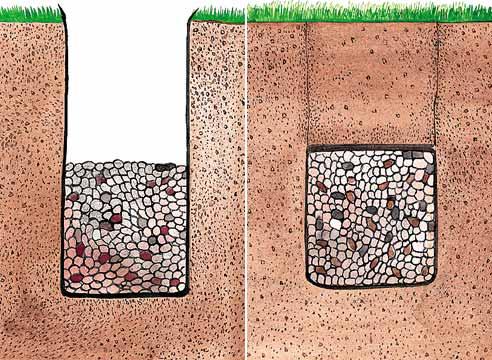
At the bottom of the trench are stacked larger stones, from above smaller.
On the perimeter of the drainage ditches can be covered with decorative gratings, and if the top layer is colored gravel, you can create dry streams on the site.
Gravel backfilling is able to keep the walls from collapse and the drainage system will serve for a long time.
Drainage system, how to do closed deep drainage
In case of flooding of the area with closely located groundwater, a deep, closed drainage is installed on the site.
The work is carried out in the following order:
- taking into account the quality of the land on the site, the depth of the pipe laying is determined. If the soil is sandy, the depth of the trench is not less than 1 meter. If the loam is the depth of the trench 80 cm, if the clay soil is 70-75 cm. Consider the depth of soil freezing in your region so that the pipes do not deform in the winter, it is better to place them below the freezing level;
-produce the selection of pipes for drainage. Perforated plastic pipes are the most economical option for laying drainage. To prevent sand and soil from getting inside the drainage perforated pipe, the perforated drainage pipes must be wrapped with geotextile. If the plot's land consists of clay, the drainage pipes can not be wrapped with geotextile, but the pipes are laid on a gravel cushion, 20 cm high. If there is loam in the ditch, gravels do not pour into the ditches, but the drainage pipes must be wrapped in geotextile or filter cloth. If there is sand on the site, the drainage pipes must be wrapped with geotextile, the pipes should be laid on a gravel pillow and gravel covered on top;
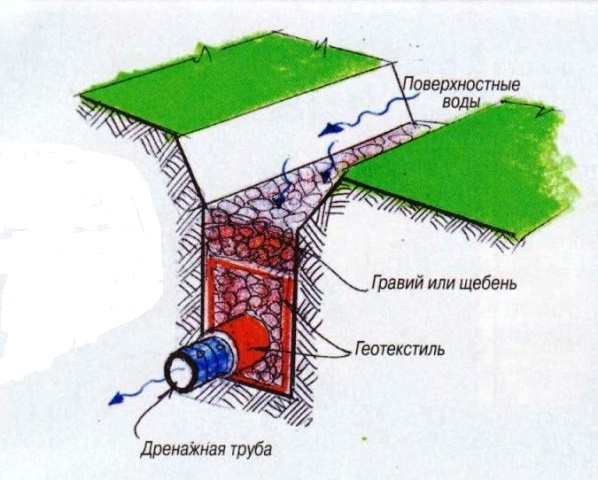
- We will prepare a place for reception of drains. If there is a possibility of removing wastewater from the site, drainage can be brought out simply into a ditch. But it is better to solve the problem by using a well to collect a drain. Wet from this well can be used for watering the garden and the garden;
- Tips for earthmoving. For every meter of the ditch dug, 5-6 cm should be accounted for the slope to the water collection point, the slope is checked by the construction level. Trenches are better to dig in the form of a Christmas tree, lateral trenches are connected in one central and from it water already goes to the well;
- Tips for preparing the bottom of the trench. To prevent plastic pipes from breaking, the bottom of the trench should not have any differences. If possible, make a cushion of cushion of large sand, 10 cm high and plus 10 cm of gravel. If you can not create a pillow, lay the geotextile for the entire length of the ditch, it will prevent the silting of the pipes. Choose a low-density filter cloth to allow water to easily enter through this tissue;

- We lay the drainage system, all pipes must be spread out in a trench, and then mount a single network using crosses and tees. The collected system is filled with sand, and rubble is poured on top. The thickness of each layer is 10-15 cm, then the trench is filled with ordinary earth with the creation of earthen ridges above the surface, during operation they will equal the ground surface.
Important! By the created drainage system, you can not ride heavy equipment, otherwise you risk destroying the drainage system.


